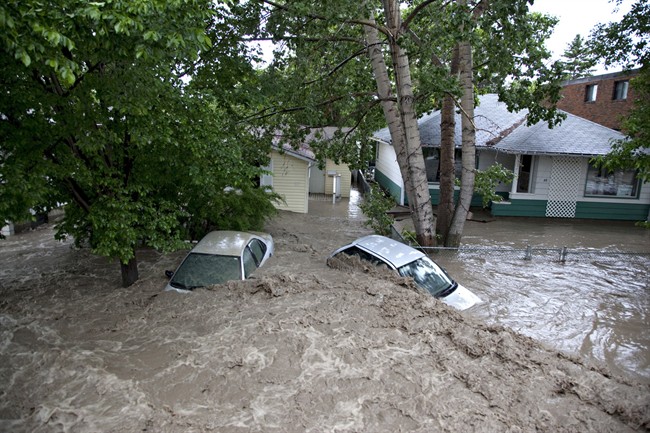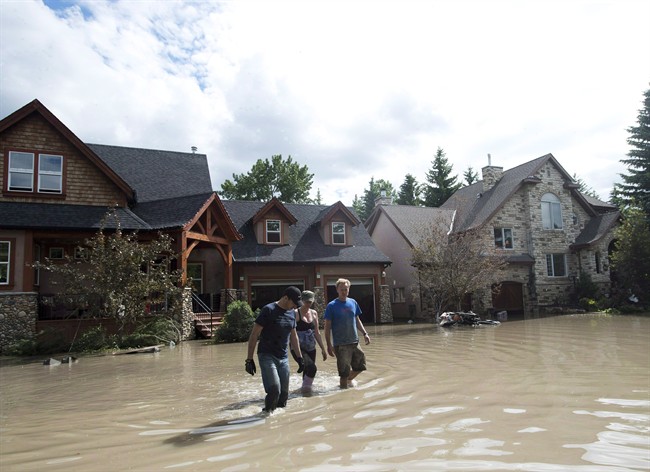The historic 2013 southern Alberta floods marked a turning point when it comes to disaster preparedness for the affected cities and towns.

In the past five years, Calgary — along with several cities, towns and communities in southern Alberta — have been cleaning up the mess left behind by the floodwater.
The natural disaster also highlighted the importance of governments working together to solve problems and ensure resident safety.
Since 2013, billions of dollars and countless hours have been spent between municipal, provincial and federal governments preparing communities for the worst.
Here’s a look at what’s been spent on projects across Alberta by different levels of government.
Municipal projects – City of Calgary
“Municipal” projects are ones being identified and led by the City of Calgary, officials told Global News. The cost of those projects is shared between the municipal, provincial and in some cases the federal government.
$6,400,000 — Municipal Complex site drainage program: downtown — complete
$19,000,000 — 12 Street Bridge rehabilitation and raising: Inglewood — complete
$1,700,000 ($1,530,000 from province) — Centre Street Bridge lower deck flood barrier: Chinatown — underway
$4,095,000 ($1,729,000 from province) — Roxboro sanitary lift station resiliency and sanitary lining: Roxboro-Rideau — complete
$2,000,000 ($1,800,000 from province) — Stormwater outfall improvements: 16 sites city-wide — underway
$3,721,000 — Sunnyside sanitary lift station: Sunnyside — complete
$630,000 ($567,000 from province) — Harvie Passage (Western Headworks Diversion Site) improvements: Inglewood — underway
$25,000,000 — Zoo flood mitigation: Calgary Zoo/Inglewood – complete
$4,800,000 ($3,960,000 from province) — Heritage Drive permanent flood barrier: Heritage – underway
$9,954,000 ($6,417,000 from province) — Sunnyside pump station #2: Sunnyside – underway
$3,200,000 ($2,115,000 from province) — West Eau Claire Flood Barrier: downtown – underway
$10,000,000 ($7,600,000 from province) — Glenmore Dam infrastructure improvement program: Glenmore Dam – underway
$38,352,000 ($4,153,000 from province) — Northwest inner-city upper plateau separation: Sunnyside – conceptual design
$9,584,000 ($3,400,000 from province, $2,100,000 from federal government) — Sunnyside pump station #1: Sunnyside – underway
$25,000,000 ($5,240,000 from province) — 9 Avenue bridge raising and bank stabilization: Inglewood – conceptual design
$26,508,000 ($11,456,000 from province, $8,400,000 from federal government) — Bonnybrook wastewater treatment plant flood protection – berm and utilities relocation: Bonnybrook – underway
$1,980,000 — Centre Street Bridge gravel bar: downtown – underway
$25,613,000 ($25,613,000 from province) — Downtown barrier: downtown – underway
$200,000 ($80,000 from province, $100,000 from federal government) — Flood risk mitigation through improved forecasting and warning: city-wide study
$250,000 ($100,000 from province, $125,000 from federal government) — Stormwater risk assessment: city-wide study
Municipal projects total: $217,987,000
Province pays: $75,760,000
Federal government pays: $10,725,000
City pays: $152,962,000

Provincial projects – Government of Alberta

Get daily National news
$2.5 billion – Total spent on flood recovery, resiliency, emergency preparedness, etc.
$154 million –To fund the restoration of residential dwellings, small businesses and agricultural properties
$333 million — To fund emergency operation costs and the restoration of damaged municipal infrastructure such as roads, bridges, parks wastewater treatment plants
$794 million — To fund province’s incremental emergency response and recovery administration costs. This includes psychosocial support programs, provision of emergency relief debit cards and hosting of evacuees, interim housing for First Nation and non-First Nation residents, repairs to damaged provincial infrastructure and the restoration of environmental habitats
$148 million –- Expected to be spent over the next three years — by the end of June 2021 — for provincial and municipal infrastructural rehabilitation projects
Of the $148 million mentioned above:
$92.5 million — To fund program administration, repairs to provincial highway infrastructure and restoration of provincial park infrastructure and environmental habitats
$55.5 million — Allocated to primarily fund repairs to municipal infrastructure
WATCH: Homes flooded, businesses under water and bridges shut down. That’s just some of the devastation Calgary saw in 2013 when the Bow and Elbow rivers flooded. Heide Pearson takes a look by the numbers.

Alberta Community Resilience Program:
- $531 million — Initial budget when the program started in 2015
- $190 million — Grant funding has been distributed to date to 42 municipalities and three First Nations
- Projects include: flood barriers, erosion control and stormwater management
Relocation:
$99.3 million — To fund the purchase of primary residences that were at risk or damaged by the June 2013 flood and located in a designated floodway. Approximately 94 properties were acquired by the province
Erosion control program:
$213 million — Grants for 24 municipalities and four First Nations
High River investments:
$65 million — High River flood mitigation (outside of grant programs mentioned above) since 2013 floods
$43.7 million ($33.7 million from Alberta Infrastructure and $10 million from Alberta Environment and Parks) — To restore High River’s Wallaceville neighbourhood to its natural state

Rocky View County investments:
$32.8 million (with maximum federal contribution of $5,589,441) — Flood barriers in Bragg Creek — project relates to the decision to proceed with the Springbank off-stream reservoir
Watershed resiliency and restoration program:
$29 million — Grants for 80 projects — when complete, projects will result in the restoration of more than 1,000 hectares of wetlands, more than 200 kilometres of riparian areas and over 8,000 hectares of riparian land placed into conservation
TransAlta agreement:
Annual compensation to TransAlta is $5.5 million to:
- Modify operations at Ghost Reservoir from May 16 to July 7 each year
- Modify operations at Barrier Lake, Upper Kananaskis Lake and Lower Kananaskis Lake year-round
Bow River options (not yet approved):
$1.75 million — The cost of the three conceptual assessments of proposed instream projects on the Bow River
$500,000 — Cost of feasibility study into increasing the drawdown rate at Ghost Reservoir
Emergency spillway upgrades for four structures in southern Alberta:
$104 million — Emergency spillway upgrades for Travers/Little Bow dam (complete), Bassano dam, Taylor Coulee waste way (complete) and Bullhorn waste way (complete)
Flood mapping
$13.5 million (up to $4 million in federal funding) — 13 new river hazard studies
SEE BELOW: Maps from the City of Calgary show what the 2013 flood impact would have been with no response to control water flow, what did happen in 2013 and what it would look like if a similar flood happened after all mitigation and resiliency projects were completed.
River forecasting
$3 million since 2013 — Improve river forecasting and better connect with municipal emergency managers and Albertans
Springbank reservoir
$372 million — Estimated net cost of the project
Non-financial
Improvements to emergency preparedness and response:
The province continues to implement recommendations from the third-party post-incident report conducted by MNP consultants, which was released in December 2015.
Of 16 recommendations, 15 were accepted and one was accepted in principle. All 15 are complete or on-track for completion. The full list of recommendations is located here.
Legislative improvements:
Bill 8, the Emergency Management Amendment Act, aimed at giving local authorities clear direction on roles and responsibilities in emergencies, is before the legislature.
Mental health supports
Albertans affected by the flood continue to have access to mental health supports through Alberta Health Services (AHS). AHS also increased its capacity immediately following the floods.
Federal projects – Departments of Public Safety, Environment
Federal Department of Public Safety:
$500 million — Disaster Financial Assistance Arrangements (DFAA) for costs incurred by the province of Alberta during the June 2013 floods — plus an interim payment of $100 million in March 2016
DFAA:
Under the DFAA, the federal government covers up to 90 per cent of the eligible costs of major natural disasters.
$2.8 billion — Amount budgeted to date for costs associated with the southern Alberta floods, as of fall 2017.
BELOW: Interactive map showing flood-affected areas in Calgary and resiliency and mitigation projects
Federal Department of Environment:
$2-billion — Soon-to-be-announced disaster mitigation and adaption fund (DMAF) from Infrastructure Canada
Aimed at addressing climate risks and protecting communities, the DMAF will support projects like wetland and dams and dikes.
$10,469,139 — Amount contributed to City of Calgary flood mitigation — eligible costs: $31,410,557
$5,589,441 — Amount contributed to Bragg Creek flood mitigation — eligible costs: $16,770,000
$545,343 — Amount contributed to south drainage diversion project in Raymond — eligible costs: $1,636,196
$14,447,565 — Amount contributed to Cougar Creek long-term flood mitigation in Canmore — eligible costs: $43,780,500
Information about the City of Calgary’s flood mitigation and resiliency plans, as well as information tips, useful links and other flood-related content can be found on the city’s website.
With files from Alannah Page















Comments